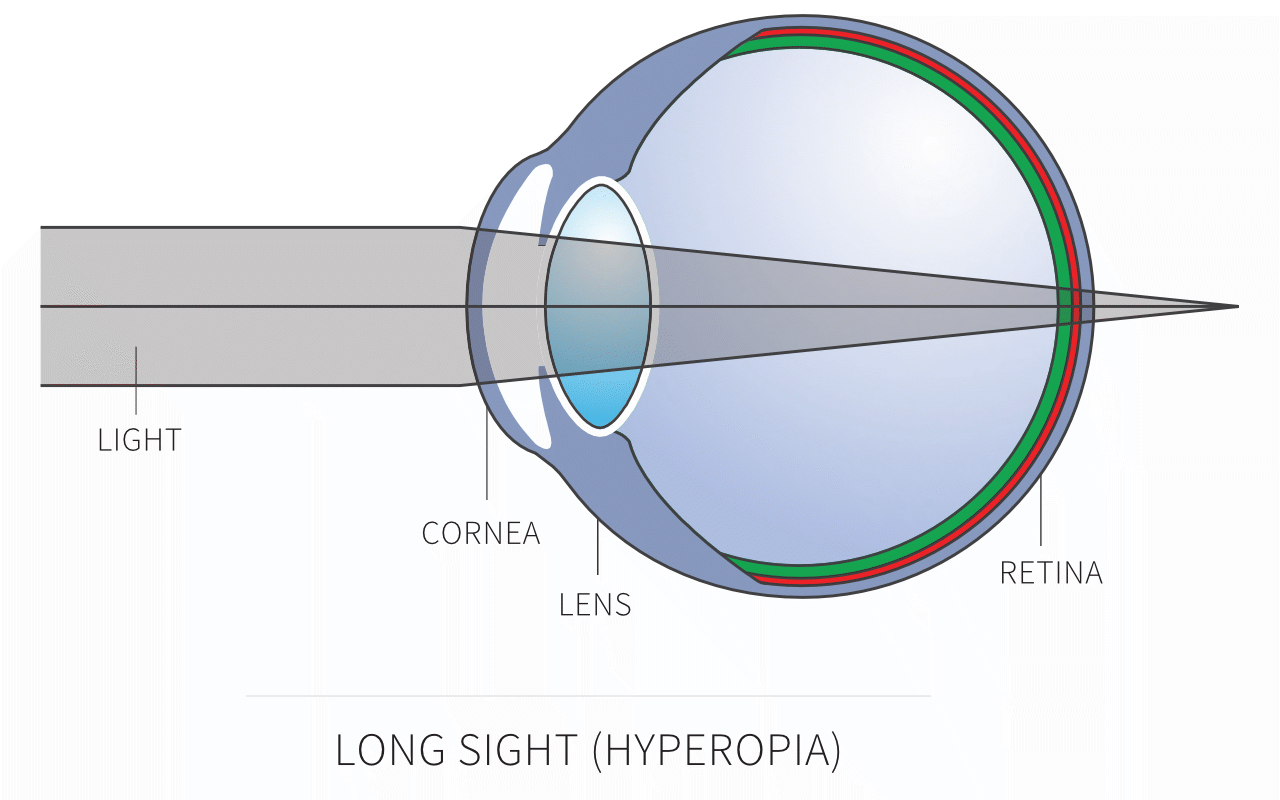020 7490 7222 Book an appointment
Long-sightedness is a common cause of reduced vision affecting 1 in 4 people in the UK. ( In the United States this condition is referred to as being farsighted.) Long-sightedness occurs in both children and adults, but it is more common in people over the age of 40 years with a tendency to worsen gradually with age. Long-sight, like short-sightedness or myopia, is a refractive error (refraction simply means the bending of light). If you are long-sighted you will see objects in the distance clearly but your near vision will be blurred. For example, you might struggle to read a menu in a restaurant or a page in a book but will be able to see films at the cinema clearly.

The way in which light is bent and focused by the eye will determine the type of visual problems experienced) and can be corrected by the use of contact lenses, glasses or laser eye surgery. There are many treatments available for long-sightedness – please do get in touch with us if you feel you are suffering from this condition. Being ‘long-sighted’ is also known as the condition ‘hyperopia’.
Long-sightedness is when light from a far object focuses at a point behind the light-sensitive layer (retina), rather than directly on its surface (think of an arrow overshooting a target). of course, this cannot happen so the lens tries to accommodate this refractive error by becoming more rounded. In younger people, this process of counteracting long-sightedness is known as accommodation. However, the resulting effect is that people with hyperopia over time cannot fully ‘accommodate’ this error and their vision for nearby objects becomes blurred.
Essentially, long-sightedness occurs when the eye is slightly too short and/or the overall focusing power of the eye is too weak. If you are long-sighted, the first number of your spectacle or contact lens prescription will be a positive number e.g. +2.00. A person has mild long-sightedness with a prescription of +2.00 or less, and high long-sightedness with +5.00DS and higher.
Long-sightedness can run in families so you’re more likely to develop it if one or both of your parents are long-sighted, or it can develop with age as the focusing ability of the eye reduces.
The answer is not as straightforward as short-sightedness – the effect on your vision depends on the strength of the prescription and your age. This is because the lens inside a young eye can change shape (accommodate) to adjust for long-sightedness, and this ability reduces over-time. In general, long-sightedness affects close-up vision (e.g. reading a book) first and with age, vision in the far distance will also become affected. This is demonstrated in the example below of a person with mild long-sightedness (+1.00) at different stages of their life:

If you are long-sighted you might struggle to read the text on your mobile phone.
When someone describes the condition of long sight they might often confuse this with ‘presbyopia’ which is something that in time we all suffer from. Presbyopia is where the eye loses it’s elasticity and therefore cannot focus well on near objects. Therefore the symptoms are very similar to long sight. However long sight is a condition that can affect young patients too.
Long-sightedness can be treated by spectacles, contact lenses or refractive surgery (laser, lens implant or other). Treatment is more likely to be needed in older adults who no longer have the ability to change their lens shape and focus their eyes.
Laser eye surgery can correct long sight and the results can often be more surprising than short sight correction – mainly because when someone suffers from long sightedness they often cannot see very much of the world around them. Long sight is more common in patients older than 35 years old. In some cases, LASIK might not be the most appropriate treatment and instead, we would sometimes recommend refractive lens exchange as an alternative. This has many benefits of treating long sight but it is always advisable to come in for a consultation first so we can determine whether presbyopia is present.
The term ‘hyperopia’ is often used to describe visionary and long-term thoughts, behaviours and actions. “We are all farsighted, we give importance to those things that are far from us while neglecting the things that are close to us… only to realize their value later when they are out-of-reach again…” Ai Yazawa, NANA: The Complete Series.